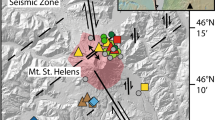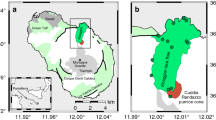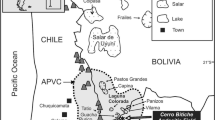Abstract
Mount St. Helens has explosively erupted dacitic magma discontinuously over the last 40,000 years, and detailed stratigraphic data are available for the past 4,000 years. During this last time period the major-element composition of the dacites has ranged from mafic (62–64 wt% SiO2) to felsic (65–67 wt% SiO2), temperature has varied by about 150°C (770°–920°C), and crystallinity has ranged between 20% and 55%. Water content of these dacites has also fluctuated greatly. Although the source for the dacitic magmas is probably partial melting of lower crustal rocks, there is strong physical evidence, such as banded pumices, thermal heterogeneities in single pumices, phenocryst disequilibrium, contrasts between compositions of glass inclusions and host matrix glass, and amphibole reaction rims, that suggests that magma mixing has been prominent in the dacitic reservoir. Indeed, we suggest that the variations in major- and trace-element abundances in Mount St. Helens dacites indicate that magma mixing between felsic dacite and mafic magma has controlled the petrologic diversity of the dacitic magmas. Magma mixing has also controlled the composition of andesites erupted at Mount St. Helens, and thus it appears that the continuum of magmatic composition erupted at the volcano is controlled by mixing between felsic dacite, or possibly rhyodacite, and basalt. The flux of the felsic endmember to the reservior appears to have been relatively constant, whereas the flux of basalt may have increased in the past 4,000 years, as suggested by the apparently increased abundance of mafic dacite and andesite erupted in this period.
Similar content being viewed by others
References
Andersen DJ, Lindsley DH (1988) Internally consistent solution models for Fe-Mg-Mn-Ti oxides: Fe-Ti oxides. Am Mineral 73:714–726
Bacon CR, Hirschmann MM (1988) Mg/Mn partitioning as a test for equilibrium between coexisting Fe-Ti oxides. Am Mineral 73:57–61
Bennett JT, Krishnaswami S, Turekian KK, Melson WG and Hopson CA (1982) The uranium and thorium decay series nuclides in Mt. Helens effusives. Earth Planet Sci Lett 60:61–69
Carey S, Gardner J, Sigurdsson H (1995) The intensity and magnitude of Holocene plinian eruptions from Mount St. Helens volcano. J Volcanol Geotherm Res (in press).
Crandell DR (1987) Deposits of pre-1980 pyroclastic flows and lahars from Mount St. Helens volcano, Washington. US Geol Surv Prof Pap 1444
Crandell DR, Mullineaux DR, Meyer R (1975) Mount St. Helens volcano: recent and future behavior. Science 187:438–441
Defant MJ, Drummond MS (1993) Mount St. Helens: potential example of the partial melting of the subducted lithosphere in a volcanic arc. Geology 21:547–550
Garcia MO, Jacobson SS (1979) Crystal clots, amphibole fraction and the evolution of calc-al-kaline magmas. Contrib Mineral Petrol 69:319–327
Gardner J (1993) Compositional diversity in volcanic deposits: implications for processes operating within magma chambers and the withdrawal of magma during explosive plinian eruptions. PhD thesis, Univ. of Rhode Island, Narragansett, RI
Gardner J, Rutherford MJ, Carey S, Sigurdsson H (1995) Experimental constraints on preëruptive water contents and changing magma storage prior to explosive eruptions of Mount St. Helens volcano. Bull Volcano (in press).
Geschwind C-H, Rutherford MJ (1992) Cummingtonite and the evolution of the Mount St. Helens magma system: an experimental study. Geology 20:1011–1014
Halliday AN, Fallick AE, Dickin AP, Mackenzie AB, Stephens WA, Hildreth W (1983) The isotopic and chemical evolution of Mount St. Helens. Earth Planet Sci Lett 63:241–256
Hoblitt RP, Crandell DR, Mullineaux DR (1980) Mount St. Helens eruptive behavior during the past 1,500 yr. Geology 8:555–559
Hopson CA, Melson WG (1990) Compositional trends and eruptive cycles at Mount St. Helens. Geosci Can 17:131–141
Leeman WP, Smith DR, Hildreth W, Palacz Z, Rogers N (1990) Compositional diversity of late Cenozoic basalts in a transect across the southern Washington Cascades: implications for subduction zone magmatism. J Geophys Res 95:19561–19582
Mullineaux DR (1986) Summary of pre-1980 tephra-fall deposits erupted from Mount St. Helens, Washington state, USA. Bull Volcanol 48:17–26
Mullineaux DR, Hyde J, Rubin M (1975) Widespread late glacial and postglacial tephra deposits from Mount St. Helens volcano, Washington. J Res US Geol Surv 3:329–335
Nielsen CH, Sigurdsson H (1981) Quantitative methods of electron microprobe analysis of sodium in natural and synthetic glasses. Am Mineral 66:547–552
Pallister JS, Hoblitt RP, Crandell DR, Mullineaux DR (1992) Mount St. Helens a decade after the 1980 eruptions: magmatic models, chemical cycles, and a revised hazards assessment. Bull Volcanol 54:126–146
Rutherford MJ, Devine JD (1988) The May 18, 1980, eruption of Mount St. Helens 3. Stability and chemistry of amphibole in the magma chamber. J Geophys Res 93:11949–11959
Rutherford MJ, Hill PM (1993) Magma ascent rates from amphibole breakdown: an experimental study applied to the 1980–1986 Mount St. Helens eruptions. J Geophys Res 98:19667–19685
Rutherford MJ, Sigurdsson H, Carey S, Davis A (1985) The May 18, 1980, eruption of Mount St. Helens, 1, Melt composition and experimental phase equilibria. J Geophys Res 90:2929–2947
Smith DR (1984) The petrology and geochemistry of High Cascade volcanics in southern Washington: Mount St. Helens volcano and the Indian Heaven basalt field. PhD dissertation, Rice University, Houston, TX
Smith DR, Leeman WP (1987) Petrogenesis of Mount St. Helens dacitic magmas. J Geophys Res 92:10313–10334
Smith DR, Leeman WP (1993) The origin of Mount St. Helens andesites. J Volcanol Geotherm Res 55:271–303
Sparks RSJ, Marshall LA (1986) Thermal and mechanical constraints on mixing between mafic and silicic magmas. J Volcanol Goetherm Res 29:99–124
Stormer JC (1983) The effects of recalculation on estimates of temperature and oxygen fugacity from analyses of multi-component iron-titanium oxides. Am Mineral 68:586–594
Volpe AM, Hammond PE (1991) 238U-230Th-226Ra disequilibria in young Mount St. Helens rocks: time constraint for magma formation and crystallization. Earth Planet Sci Lett 107:475–486
Yamaguchi DK (1983) New tree-ring dates for recent eruptions at Mount St. Helens. Quat Res 20:246–250
Yamaguchi DK (1985) Tree-ring evidence for a two-year interval between recent prehistoric explosive eruptions of Mount St. Helens. Geology 13:554–557
Author information
Authors and Affiliations
Rights and permissions
About this article
Cite this article
Gardner, J.E., Carey, S., Rutherford, M.J. et al. Petrologic diversity in Mount St. Helens dacites during the last 4,000 years: implications for magma mixing. Contr. Mineral. and Petrol. 119, 224–238 (1995). https://doi.org/10.1007/BF00307283
Received:
Accepted:
Issue Date:
DOI: https://doi.org/10.1007/BF00307283




